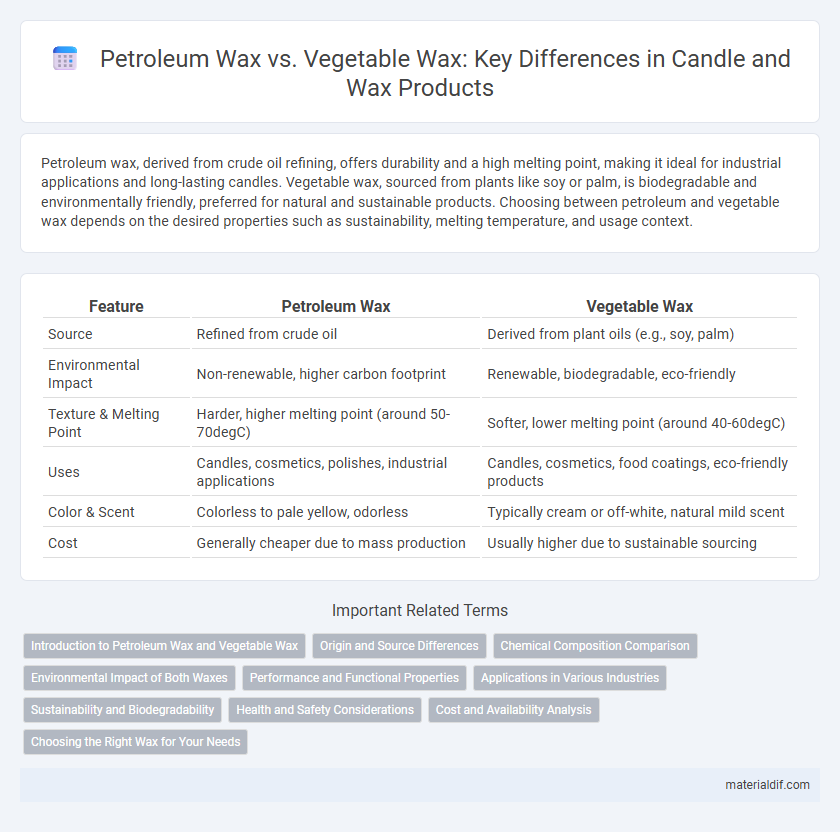Petroleum wax, derived from crude oil refining, offers durability and a high melting point, making it ideal for industrial applications and long-lasting candles. Vegetable wax, sourced from plants like soy or palm, is biodegradable and environmentally friendly, preferred for natural and sustainable products. Choosing between petroleum and vegetable wax depends on the desired properties such as sustainability, melting temperature, and usage context.
Table of Comparison
| Feature | Petroleum Wax | Vegetable Wax |
|---|---|---|
| Source | Refined from crude oil | Derived from plant oils (e.g., soy, palm) |
| Environmental Impact | Non-renewable, higher carbon footprint | Renewable, biodegradable, eco-friendly |
| Texture & Melting Point | Harder, higher melting point (around 50-70degC) | Softer, lower melting point (around 40-60degC) |
| Uses | Candles, cosmetics, polishes, industrial applications | Candles, cosmetics, food coatings, eco-friendly products |
| Color & Scent | Colorless to pale yellow, odorless | Typically cream or off-white, natural mild scent |
| Cost | Generally cheaper due to mass production | Usually higher due to sustainable sourcing |
Introduction to Petroleum Wax and Vegetable Wax
Petroleum wax, derived from the refining of crude oil, is a hydrocarbon-based substance widely used in candle making, cosmetics, and packaging for its hardness, opacity, and slow burning properties. Vegetable wax, extracted from plants such as soybeans, palm, or coconut, offers a renewable and biodegradable alternative with a softer texture and cleaner burn, making it popular in eco-friendly candle production and skincare products. The primary differences rest in their origin, environmental impact, and melting points, with petroleum wax typically exhibiting higher melting temperatures compared to most vegetable waxes.
Origin and Source Differences
Petroleum wax originates from crude oil refining, primarily derived as a byproduct during the de-oiling of slack wax in the petrochemical industry, whereas vegetable wax is extracted from plant-based sources like soybeans, palm, or carnauba leaves. Petroleum wax is composed mainly of hydrocarbons, while vegetable wax consists of long-chain esters, acids, and alcohols, reflecting their distinctive biogenic origins. The sustainable sourcing of vegetable wax offers an eco-friendly alternative to petroleum wax, which relies on non-renewable fossil fuels.
Chemical Composition Comparison
Petroleum wax primarily consists of long-chain saturated hydrocarbons derived from crude oil refining, including paraffins, microcrystalline waxes, and ceresin, offering high melting points and durability. Vegetable waxes, such as soy, carnauba, and candelilla, are composed of esters, fatty acids, and alcohols from plant oils, providing biodegradability and a lower melting point. Chemical composition differences influence their burning properties, texture, and environmental impact, making petroleum wax more stable but less eco-friendly than vegetable waxes.
Environmental Impact of Both Waxes
Petroleum wax, derived from non-renewable fossil fuels, contributes significantly to carbon emissions and environmental pollution during extraction and processing. Vegetable waxes, sourced from sustainable plants like soy, palm, or candelilla, offer a biodegradable and renewable alternative with a lower carbon footprint. However, vegetable wax production can impact land use and biodiversity if sourced unsustainably.
Performance and Functional Properties
Petroleum wax, primarily derived from crude oil refining, offers superior hardness, high melting points, and excellent moisture resistance, making it ideal for applications requiring durability and long shelf life. Vegetable waxes, sourced from natural plants like soy or palm, provide biodegradability, renewable origins, and better scent throw, but tend to have lower melting points and softer textures affecting structural integrity. Performance differences significantly impact product selection in candle making, cosmetics, and coatings, with petroleum wax favored for robustness and vegetable wax preferred for eco-friendly attributes.
Applications in Various Industries
Petroleum wax, derived from refining crude oil, is widely used in industries like candle making, cosmetics, food packaging, and pharmaceuticals due to its excellent moisture barrier and high melting point. Vegetable wax, sourced from plant materials such as soy, palm, and candelilla, is preferred in eco-friendly applications including natural candles, cosmetics, and biodegradable packaging because of its sustainable and non-toxic properties. Both types of waxes serve critical roles in manufacturing, but petroleum wax dominates in industrial durability while vegetable wax is favored for environmental sustainability.
Sustainability and Biodegradability
Vegetable waxes offer enhanced sustainability by being derived from renewable plant sources like soy, palm, or candelilla, significantly reducing reliance on finite petroleum resources. Unlike petroleum waxes, which are byproducts of fossil fuels and are non-biodegradable, vegetable waxes decompose naturally, minimizing environmental impact and improving biodegradability. Choosing vegetable wax supports eco-friendly production cycles and lowers carbon footprints compared to conventional petroleum-based wax alternatives.
Health and Safety Considerations
Petroleum wax, derived from crude oil, contains hydrocarbons that may emit harmful fumes when burned, posing respiratory risks and potential skin irritation. Vegetable waxes, such as soy or beeswax, are biodegradable and generally considered safer for indoor use due to their natural origin and lower toxicity. Health-conscious consumers often prefer vegetable waxes to minimize exposure to synthetic compounds and reduce environmental impact during candle use.
Cost and Availability Analysis
Petroleum wax, derived from crude oil refining, is significantly more cost-effective and widely available compared to vegetable wax, which is sourced from plants like soy or palm and tends to be pricier due to agricultural constraints. The global production of petroleum wax benefits from established petrochemical infrastructure, ensuring consistent supply and lower prices. In contrast, vegetable wax availability fluctuates with crop yields and seasonal factors, leading to higher costs and less market stability.
Choosing the Right Wax for Your Needs
Petroleum wax, derived from crude oil, offers excellent odor control and long burn times, making it ideal for candles and industrial applications requiring durability. Vegetable wax, sourced from plants like soy or palm, provides a renewable, biodegradable option favored for eco-friendly products and sensitive skin cosmetics. Selecting the right wax depends on prioritizing sustainability, burn quality, or application-specific properties such as fragrance retention and melting point.
Petroleum Wax vs Vegetable Wax Infographic

 materialdif.com
materialdif.com